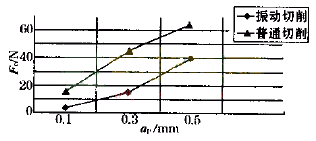Test and measurement results and analysis The relationship between the feed amount obtained by the test and the cutting force is shown in Fig. 3. It can be seen from the figure that as the feed rate increases, the cutting resistance increases, and the normal cutting force and the vibration cutting force increase, but the vibration cutting force increases faster. The reason is that with the feed rate and As the feed resistance increases, the amplitude of the vibration cutting decreases, resulting in a faster increase in cutting force. Since the large feed amount during vibration cutting may cause low-frequency vibration of the tool holder, the feed amount used in this test is small to ensure the machining accuracy and the surface quality. Test and measurement results and analysis A comprehensive analysis of the single-factor relationship between cutting force and cutting parameters during normal cutting and ultrasonic vibration cutting shows that: When the cutting speed v is greater than the critical cutting speed, ultrasonic vibration turning still has the above characteristics; when v increases to a certain value, the increase of the cutting force tends to be gentle. The orthogonal test of cutting force for ultrasonic vibration turning of SiC p /Al metal matrix composites was carried out. The relationship between cutting force and cutting parameters was discussed by regression orthogonal analysis, and the most suitable vibration cutting parameters were selected. The rotational speed, feed rate and depth of cut are the three most important and essentially independent parameters in the turning process. Therefore, the above three parameters are selected as orthogonal test factors. Using the L 9 (2 3 ) orthogonal table as a three-factor, three-level orthogonal test (regardless of interaction), the test factor level table shown in Table 4 was established. According to the cutting conditions listed in Table 4, using the L 9 (2 3 ) orthogonal table, the cutting force test data shown in Table 5 can be obtained. Cutting depth a p (mm) 0.1 0.3 0.5 Vibration cutting force F c (N) 3.60 14.80 39.72 Ordinary cutting force F c (N) 15.30 45.50 64.50 
Figure 4 Relationship between depth of cut and cutting force Test factor Speed ​​(m/min) Feed rate (mm/r) Cutting depth (mm) Level 1 4.24 0.08 0.10 Level 2 8.48 0.10 0.30 Level 3 12.72 0.15 0.50 Test number Rotating speed
(m/min) Feed rate
(mm/r) Cut depth
(mm) Radial cutting force
(N) Main cutting force
(N) 1 4.24 0.08 0.10 4.18 2.58 2 4.24 0.10 0.30 10.30 7.03 3 4.24 0.15 0.50 24.30 36.14 4 8.48 0.08 0.30 13.76 8.14 5 8.48 0.10 0.50 23.00 30.00 6 8.48 0.15 0.10 10.18 3.12 7 12.72 0.08 0.50 27.47 33.30 8 12.72 0.10 0.10 6.29 4.00 9 12.72 0.15 0.30 10.56 8.00
Effect of feed rate on cutting force Influence of cutting depth on cutting force Multi-factor orthogonal test scheme
Previous page next page